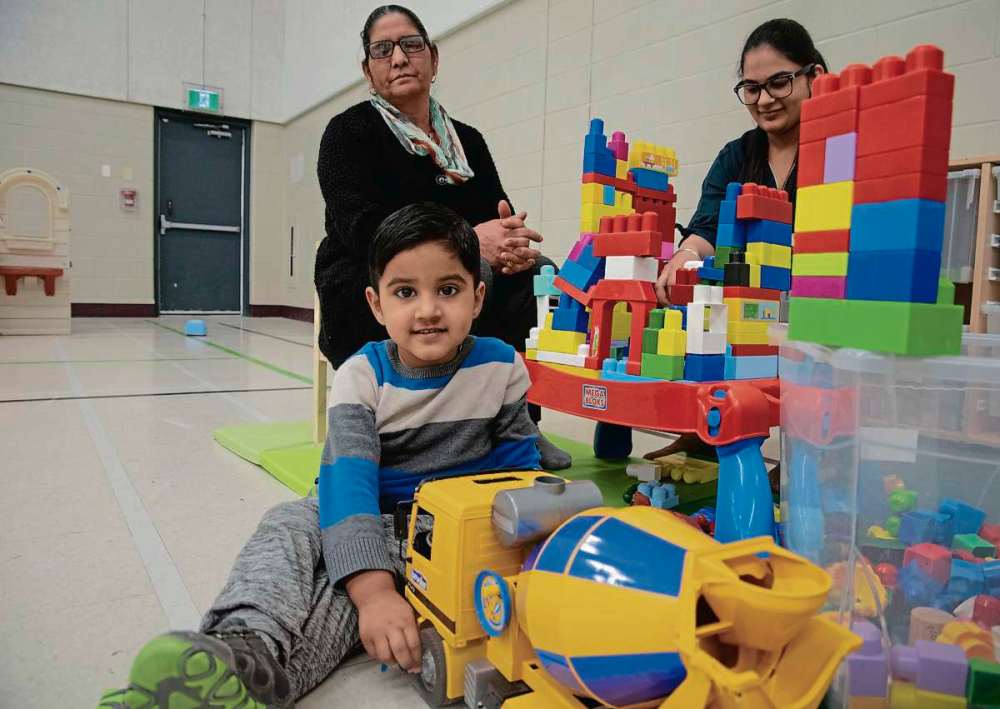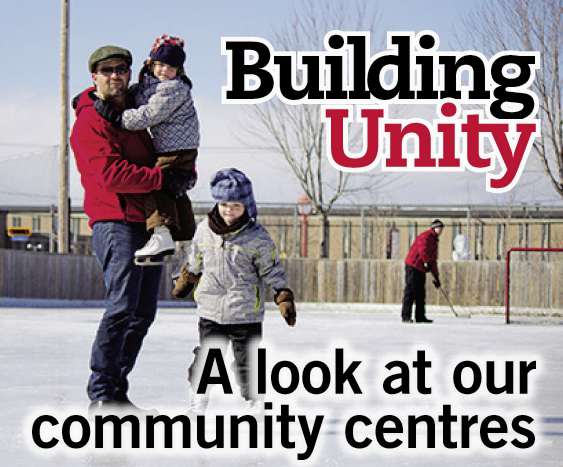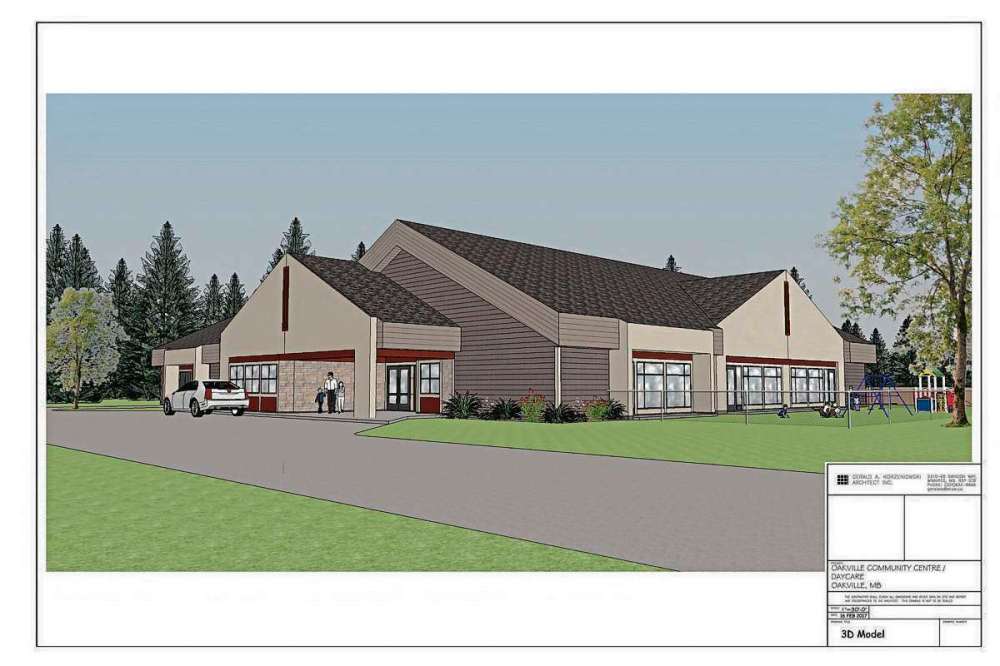Evolving to meet diverse needs
Advertisement
Hey there, time traveller!
This article was published 07/05/2019 (2377 days ago), so information in it may no longer be current.
Last week, we looked at the challenges faced by community centres in and around Winnipeg. This week, in the third and final instalment of our three-part series, Building Unity: A look at our community centres, we look at how those centres are planning for the future.
As communities in and around Winnipeg continue to grow and change, so too must their community centres.

The volunteer boards and management of local community centres continue to explore ways to ensure their relevance in the future. Targeted programming, facility overhauls and amalgamation are just some of the ideas being kicked around board tables in community halls.
At Whyte Ridge Community Centre, a small club tucked away in southwest Winnipeg, a new volunteer has joined the ranks, with the sole responsibility of serving the neighbourhood’s diverse population.
Shahin Shooshtari is a Canadian-Iranian who was appointed as the centre’s diversity director, tasked with recognizing, serving, and celebrating diverse cultures and groups in the neighbourhood.
Shooshtari said Whyte Ridge CC now mainly offers programs for children. While parents might become involved with the centre when their children are young, there is little to attract them in later years. She also believes it’s important to reach out to newcomer families and get them involved as program participants and volunteers.
“There is more that our community centres can do,” she said.
As a first step, she organized a cultural diversity evening that featured ethnic foods and entertainment. About 70 attended, including a family that had only lived in Winnipeg for a week.
In the future, she sees the community centre becoming a social gathering place for all ages, including middle-aged and older adults. Having the chance to meet others who live in their neighbourhood promotes connections and increases the feeling of being safe. For recent immigrants, it also helps them learn about their new home.
“People should learn to connect to their community,” Shooshtari said.
Dealing with changing demographics
The most recent Statistics Canada census data, from 2016, shows close to one in five Winnipeggers is 65 and over, and about one in six people fall within this age group in the surrounding municipalities.
Growth in rural communities surrounding Winnipeg is generated mainly by people leaving the city for rural lifestyles and looking for the amenities they enjoyed in an urban setting.
While the populations of some parts of Winnipeg are slowly aging, other neighbourhoods are experiencing a steady growth in newcomer populations. According to Statistics Canada, 4.3 per cent of the country’s total number of new immigrants for 2016 settled in Winnipeg.

Community centres often rely on volunteers to operate, and as more people choose the Winnipeg metropolitan area as their home, introducing and engaging newly arrived folks in local clubs will be crucial.
A professor in the University of Manitoba’s Department of Community Health Sciences, Shooshtari has lived in Whyte Ridge for 14 years. She was a founding member of the Iranian Community of Manitoba (ICM), serving on its board for six years, as well as being the chairperson of the Persian language classes committee for a decade.
Her work with newcomers to Winnipeg made her realize there is a disconnect between programming at her local community centre and the needs of new Canadians who live in the southwestern section of the city.
By seeing examples of volunteerism within the community centre setting, newcomers can also discover how important volunteering is to their neighbourhood and city.
Shooshtari said Whyte Ridge CC also needs to ensure that the centre is accessible to everyone and is offering recreational and social opportunities for seniors and those with disabilities.
In northwest Winnipeg, Garden City Community Centre provides an example of how a facility can meet the needs of an aging population.
“The 55-plus demographic is definitely increasing in this area,” said the centre’s office manager Margie Reis.
The targeted programs at the centre draw seniors from as far away as Charleswood and Transcona, she said.
“We have a senior-led council advising us,” Reis said. “We listen to what they want.”
As well as giving older adults the opportunity to join in classes, the centre is a place where people can simply meet.
“We’re seeing friendships and groups forming. (Socializing) is almost equal in importance as the physical activity.”

Reis said as older adults are generally staying physically fit longer, the demand for exercise and sports programming increases. A weekly bocce group draws about 40 people.
For those on fixed incomes, the centre’s ability to run free programs is also a draw.
Reis and the centre’s staff and board are exploring ways to help immigrant seniors travel to and from the centre, as many don’t drive or have their own vehicle and might not feel comfortable using public transportation on their own.
The push to develop new, bigger, better facilities
North of Tyndall Park Community Centre, residential development has boomed with new homes being built in the Waterford Green neighbourhood in northwest Winnipeg. However, infrastructure growth at the centre has stagnated and it’s a trend affecting several suburban Winnipeg communities.
“We are kind of limited in the programs that we run, only because we have access to the gym Monday to Friday from 6 to 9 or 10 p.m.,” said Jennifer Ferguson, TPCC board president. “We are one of the only community centres in this quadrant that is really running consistent programming.”
The community centre is forced to offer programs in the nearby school gym, as it has no gym of its own. Tyndall Park is currently working with the City of Winnipeg on a feasibility study to see if it can get a gym added to its building.
“If they build it, I think that will really energize this community,” Ferguson said.
A 2018 asset management plan published by the City of Winnipeg demonstrates a strong demand for newer facilities and multiplexes to meet community needs. Many Winnipeg facilities were built before the Unicity amalgamation of 1972, and without regular investment they are deteriorating.
Pair that with a three-year forecasted population growth of 36,700 new residents within Winnipeg — and 39,400 more in municipalities around the city — and centres are pinched for space as well.
The City’s public service has launched a 10-year capital project to invest approximately $4 billion in infrastructure, with $199 million going toward community services.

The General Council of Winnipeg Community Centres’ Plan 2025 acknowledges the urgency to develop more flexible multi-purpose space to meet the changing needs of the community, while ensuring that existing facilities meet program requirements. Access to full-size gyms, sports fields for children and youth, and wellness and active living facilities for adults and seniors are priorities, the report states.
And momentum is building as new infrastructure is built.
In 2012, the Sturgeon Creek and Silver Heights community centres amalgamated to become Sturgeon Heights Community Centre. The new $5.63-million facility at 210 Rita St. was funded by all levels of government and has 18,000-square-feet of indoor space.
“Old community centres were just a drain, they needed so much renovation work. Some of them have been around for 67 years and they just thought in the long run it would make more sense,” said Linda Smiley, Sturgeon Heights board president.
In northwest Winnipeg, Garden City CC celebrated the opening of the Seven Oaks Arena in 2015. With funding from the province and the City, the club built a 102,700-square-foot facility that includes two NHL-sized ice rinks. Officials are now counting 300,000 visits to the community centre each year.
The increased demand for recreational facilities has spurred neighbours, businesses, non-profits and politicians alike to work together. City councillor Janice Lukes (Waverley West) has been advocating for a recreation campus in southwest Winnipeg for four years, and has been working with all levels of government to make the project a reality.
The Waverley West recreation campus project is a combined effort of the South Winnipeg Community Centre, the City of Winnipeg and multiple other stakeholders. Nine organizations support the initiative and have formed the South Winnipeg Action Team, representing more than 55,000 residents.
Maples Community Centre is also planning an expansion, requiring the demolition of the old club to make room for a new, two-storey community centre with 10 full-size basketball courts. The centre’s board of directors has formed a building committee to negotiate with all three levels of government to ensure funding for the approximately $24-million project.
In rural communities, the idea to combine community recreational space with a non-profit organization under the same roof is also taking hold. Oakville Community Club is currently working to obtain the approximately $2.5 million it will take to build a new facility that includes a community hall and daycare centre.
Club president Dennis Galbraith said the idea for a daycare centre came about 10 years ago, when the club canvassed the community to decide whether to renovate its then-60-year-old hall or build a new hall.
Galbraith said Oakville, located about 24 kilometres east of Portage la Prairie, is experiencing steady residential growth with 61 new homes constructed in the last two years, and development of 16 more single-family homes and a fourplex underway.
“For us it’s a massive boom,” he said, pointing to new commercial expansion in Portage as fuelling the demand for housing there and in Oakville.The community club hopes work on the new facility will start next summer. It will be situated next to the hockey and curling rinks.

“What we’re doing is building a keystone building,” Galbraith said. “We’re being careful to position the building.”
Collaboration, amalgamation, and CEOs: the future of community centre operations
In communities where new facilities are not in the cards, at least not anytime soon, creative alternatives are being implemented.
In the weeks leading up to Christmas, folks running three community centres in west Winnipeg decided to combine their efforts to celebrate the season. In 2018, the Varsity View, Westdale, and Roblin Park community centres hosted their first Breakfast with Santa together in December.
“We held it at Roblin Park, but we got three or four volunteers from each club, which was easy to do,” Varsity View board president Murray Cunningham said. “Instead of getting 15 people and doing it just here for the Varsity View catchment, there was well over 200 people who attended.
“It was really rewarding and it was really good for the community as a whole, and I think we’re going to try and do that a little bit more moving forward,” Cunningham said.
The sharing of resources, facilities, and programs among community centres has become commonplace in urban settings, particularly given a climate of low volunteerism and thin profit margins. At centres without gym facilities or arenas, sports programming is often offered at a nearby facility, and community centres are quick to refer people elsewhere if programs aren’t available.
In some cases, however, amalgamation is an enticing option for centres serving a large community with few resources to pull from.
In 2014, the Richmond Kings Community Centre and Waverley Heights Community Centres were dissolved to form the South Winnipeg Community Centre. At the time, the amalgamation was said to be a way to improve the functionality of the centres; reduce duplication of effort, resources and volunteers; reduce operating costs; and allow for the expansion of current programs.
Other centres that are the product of amalgamation include Corydon CC, Fort Garry CC, Sturgeon Heights CC and Valour CC.
In the future, community centres may also be forced to partner with groups outside of the GCWCC to continue to carry out their mandate.

In its 2018-2020 business plan, the GCWCC calls for partnership opportunities among centres, city programs, and schools for program delivery, communications and resource-sharing to meet community demand.
In east Winnipeg, Bronx Park Community Centre has enjoyed a symbiotic relationship with the Good Neighbours Active Living Centre, an independent non-profit organization serving seniors, for a number of years.
“There is no other community centre like this, operating under these arrangements with a user group like Good Neighbours,” said Joseph Gatien, past president at Bronx Park.
Built in the early 1950s, Bronx Park was beginning to show its age, Gatien said, and the City of Winnipeg had approached Bronx Park with an idea to build a brand-new building with the two organizations in mind.
In 2009, the City built the new Bronx Park Community Centre at 720 Henderson Hwy. Good Neighbours uses the space for its programming Monday to Friday from 8 a.m. to 4:30 p.m. Bronx Park books the space from 4:30 p.m. on weekdays and on weekends.
“They haven’t tried this elsewhere. This is a shared-space arrangement, where they have a certain amount of the building to themselves for certain hours, then we come in and use it too,” Gatien said. “The renovations, the board really thinks the City hit it out of the ballpark with the design of this space.”
As the consolidation of sports under district associations continues and investment is concentrated in regional recreation facilities, community centres may be looking to refresh their governance models.
In southeast Winnipeg, Dakota Community Centre opened a new 60,000-square-foot fieldhouse in October 2017. Chief executive officer Michele Augert said the centre’s evolution from a volunteer to professional governance structure came out of necessity.
“Being a multimillion (dollar) annual operating facility, you can’t rely on volunteers,” Augert said. “It’s more than a full-time job to do the books for Dakota, to process all the financial transactions and to produce the monthly financial statements and those kinds of things.”
The centre boasts twin indoor ice rinks and maintains 28 fields in the community. Thousands of children access sports through Dakota on an annual basis, and even more adults come through the doors for recreation programs. There are 18 full-time staff on the centre’s payroll, and another 100 people are employed on a part-time basis. The doors to the centre are open nearly year-round, from 6 a.m. to late.
Augert said as operational complexities grow, boards tend to evolve and shift their focus toward policy direction, while operations, guided by policy, are handled by senior management.

“That’s exactly what has transpired here in the last number of years. Mostly that happened as we were taking on this big $20-million fieldhouse project and a multimillion dollar fundraising campaign,” she said.
Dakota also has a full-time programming and youth sports facilitator who works with volunteer sports convenors to run programs.
“I think it’s a natural evolution of an organization; of its growth and maturity,” she said. “It’s getting harder and harder to get people to volunteer and to help, so to leave the running of a facility of (this) size in the hands of volunteers would be unfair.”
Whether or not the large, regional recreational centre model has diminished the spirit of the community centre is an interesting question, Augert said.
In St. Vital and St. Boniface, children play hockey for regional teams under the umbrellas of the St. Boniface and St. Vital minor hockey associations, while the Dakota Lazers moniker is reserved for some soccer programs. Because of online sports registration, some families in baseball or soccer may never actually set foot inside the centre at all, Augert said.
“I wouldn’t say there’s a spirit that’s diminished. I think there is a lack of understanding of what the role is of the community centre and what role that plays in the lives of the people we’re here to serve.
“We’re working very hard here to engage our community.”
— with files from Sheldon Birnie, Simon Fuller and Eva Wasney

Andrea Geary
St. Vital community correspondent
Andrea Geary was a community correspondent for St. Vital and was once the community journalist for The Headliner.
Our newsroom depends on a growing audience of readers to power our journalism. If you are not a paid reader, please consider becoming a subscriber.
Our newsroom depends on its audience of readers to power our journalism. Thank you for your support.




